Red Sandalwood (Pterocarpus santalinus): Benefits & Uses For Skin
In the realm of natural remedies, few ingredients boast a legacy as rich and enduring as Red Sandalwood, scientifically known as Pterocarpus santalinus. This exquisite gift from nature has been cherished for centuries, revered not only for its vibrant crimson hue but also for its myriad health benefits. In this comprehensive guide, we delve into the depths of Red Sandalwood’s botanical and therapeutic properties, unveiling its secrets and the wonders it can work for your well-being.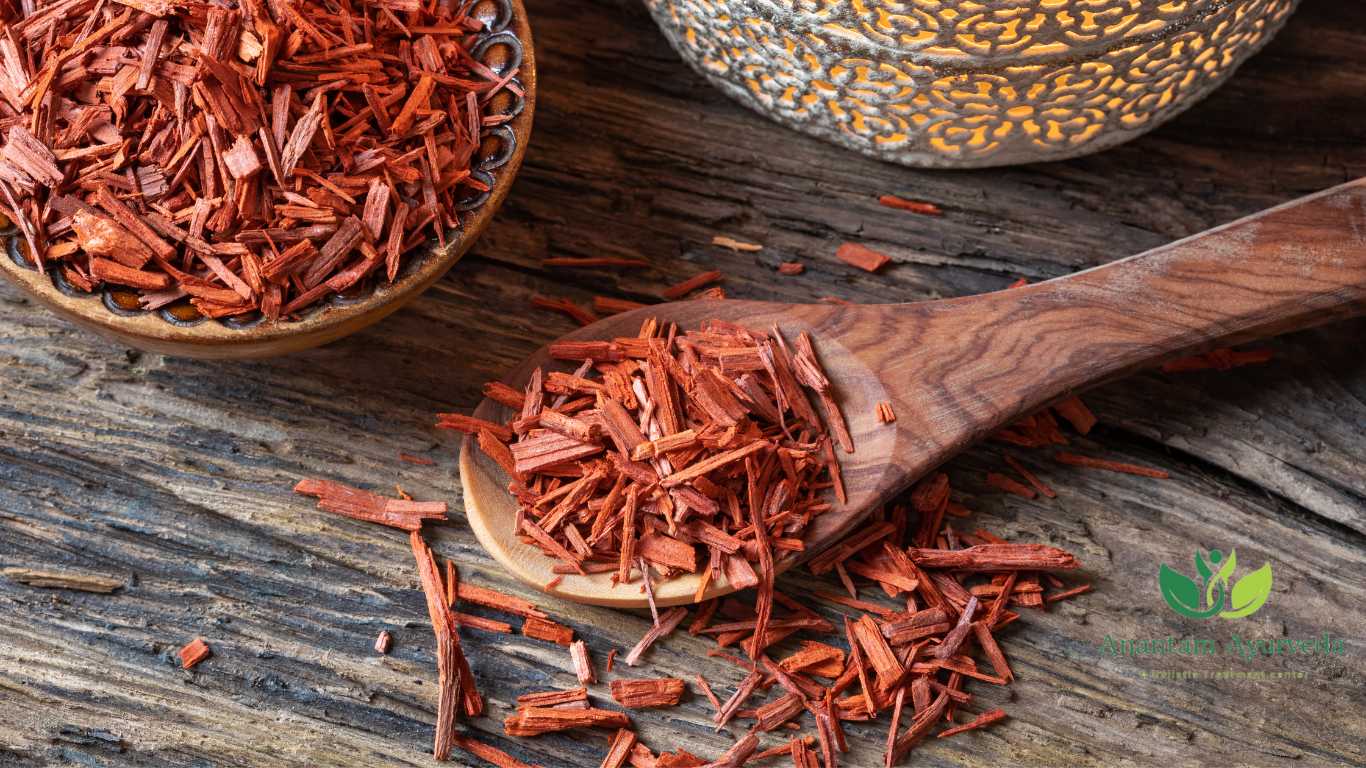
What is Red Sandalwood?
Rakta Chandan is a small to medium-sized tree native to the southern regions of India. This magnificent tree is renowned for its vibrant crimson heartwood. Scientifically known as Pterocarpus santalinus belongs to Fabaceae family. it holds a special place in Ayurvedic medicine and traditional practices.
It possesses a unique blend of qualities, including a slightly bitter taste (tikta), lightness (laghu), and a cooling potency (shita virya). This makes it an integral component of Ayurvedic remedies, helping balance doshas, soothe skin ailments, and provide relief from conditions related to excess heat and inflammation.
Classical Categorization of Red Sandalwood (Rakta chandan)
In classical Ayurvedic texts, Rakta chandan is categorized under different groups based on its properties and uses:
-
Sushruta:
-
Patoladi
-
Sarivadi
-
Priyangvadi
-
-
Vagbhata:
-
Patoladi
-
-
Kaiyadeva Nighantu:
-
Oshadhi Varga
-
-
Dhanvantari Nighantu & Raja Nighantu:
-
Chandanadi Varga
-
-
Bhavaprakasha Nighantu:
-
Karpooradi Varga
-
Vernacular Names of Red Sandalwood (Rakta chandan)
Rakta chandan is known by different names in various languages, reflecting its widespread use across cultures.
-
English: Red Sandalwood, Red Sanders
-
Hindi:
-
Lalchandan
-
Rakt Chandan
-
Lal Chandan
-
Ragat Chandan
-
Rukhto Chandan
-
Undum
-
-
Telugu:
-
Erra Chananam
-
Perra Chandanamu
-
Agaru Gandhamu
-
Erra Chandanam
-
Rakta Gandham
-
-
Gujarati:
-
Ratanjali
-
Lal Chandan
-
-
Malayalam:
-
Tilapaparni
-
Patrangam
-
Raktachandanam
-
-
Kannada:
-
Rakta Chandana
-
Honne
-
-
Tamil:
-
Shivappu
-
Atti
-
Chensandanam
-
Semmaram
-
Sivaffu Chandanam
-
-
Arabic: Sandal Ahamar
-
Parsi: Sandal Surh
-
Bengali: Rakta Chandan
-
Marathi:
-
Tambada Chandan
-
Raktachandan
-
These names reflect the cultural and linguistic diversity in the recognition and use of Red Sandalwood, showcasing its significant role in traditional medicine, religious practices, and even as a dye.
Sanskrit Synonyms of Red Sandalwood (Rakta chandan)
It is known by various Sanskrit names, each highlighting different aspects of its properties and uses:
-
Rakta chandan – The primary Sanskrit name.
-
Raktasaara – The essence or heartwood.
-
Raktanga – Refers to the red-colored wood.
-
Ranjana – Used in coloring clothes, highlighting its role as a dye.
-
Harichandan – Used in religious and spiritual practices.
-
Tamra Sara – Coppery red wood, referencing its reddish hue.
-
Tamradru – Another term denoting its reddish-brown color.
-
Kshudra Chandana – A variety of sandalwood with similar medicinal properties to white sandalwood, but considered slightly inferior.
-
Tilaparna – Referring to the appearance of the leaves, similar to sesame leaves.
-
Pravalaphala – The fruit resembles Pravala (coral), emphasizing the appearance of its fruit.
These synonyms reflect the versatility of Rakta chandan, especially in its varied uses in both medicinal and cultural contexts.
Habitat of Red Sandalwood
Rakta chandan thrives in the tropical and subtropical climates of Southern India, particularly in states such as:
-
Karnataka
-
Tamil Nadu
-
Andhra Pradesh
It typically grows at elevations up to 3000 feet above sea level, flourishing in these highland areas with favorable weather conditions.
Morphology of Red Sandalwood
Rakta chandan is a small tree species with distinctive characteristics:
-
Height: It grows up to 25 feet.
-
Heartwood: The heartwood is deep purple in color and known for its hardness, making it valuable for various uses.
-
Leaves: The leaves are compound, consisting of 3-5 leaflets. The undersides of the leaves are pale and covered with fine hairs.
-
Inflorescence: The flowers appear in few-flowered axillary or terminal racemes.
-
Fruit: The fruit is a pod with a short stalk, which further adds to the distinct nature of this plant.
It is a highly prized tree, not only for its medicinal uses but also for its aesthetic and spiritual significance. Its presence in both Ayurvedic medicine and religious practices demonstrates its versatility and importance in Indian culture.
The Chemical Composition and Useful Parts of Red Sandalwood
The magic lies in its complex chemical composition. It contains a unique mix of compounds, including santalin, santarubin, pterocarpol, and pterocarpenes. These constituents are responsible for the vibrant red color and therapeutic properties that make it a sought-after natural remedy.
The primary useful part of the Red Sandalwood tree is its heartwood, which is harvested and processed to create powders, oils, and extracts for medicinal and cosmetic applications.
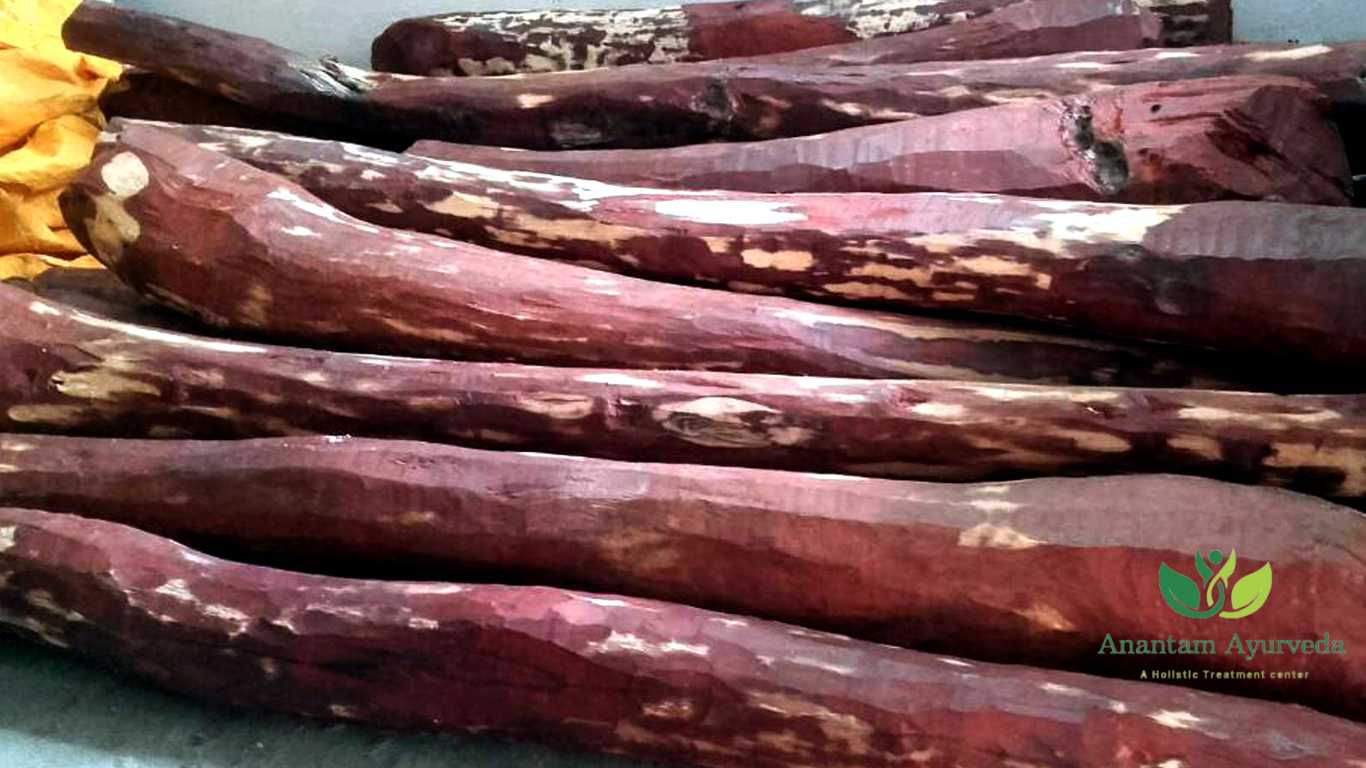
Qualities of Red Sandalwood According to Ayurveda
Medicinal Properties of Raktachandana
Guna (Qualities):
-
Guru – Heavy to digest, promotes a sense of fullness
-
Rooksha – Dry, helpful for countering excess moisture in the body
Rasa (Taste):
-
Tikta – Bitter, a key flavor for detoxification
-
Madhura – Sweet, balancing the bitter effects
Vipaka (Post-Digestive Effect):
-
Katu – Pungent taste after digestion, stimulating the body’s internal systems
Veerya (Potency):
-
Sheeta – Cold potency, acts as a natural coolant
Effect on Tridosha:
-
Helps balance Kapha and Pitta doshas, making it ideal for those with excess heat or moisture in their systems.
Prabhava (Special Effects):
-
Chakshushya – Improves vision and benefits eye health
-
Vrushya – Acts as an aphrodisiac, boosting vitality and stamina
Parts Used from the Raktachandana Plant
-
The heartwood of the Red Sandalwood tree is the primary part used in medicinal preparations.
Raktachandana Dosage
To harness the therapeutic effects of Raktachandana, it’s essential to use it in the right forms and quantities:
-
Powder: 3-6 g per day, divided into doses
-
Decoction (Kashaya): 50-100 ml per day
-
Oil (Taila): 2-25 drops, depending on the intended use
These doses can vary based on individual health needs and should be taken under the guidance of an Ayurvedic practitioner.
Raktachandana offers a range of health benefits, especially for the skin, eyes, and overall mental well-being:
-
Sheetala (Cooling Effect): Helps to cool down excess heat in the body, particularly beneficial during hot weather or for those with pitta imbalances.
-
Rooksha (Drying Effect): Ideal for managing excess moisture or oiliness in the body.
-
Tiktabha (Mildly Bitter): The slightly bitter taste helps detoxify and cleanse the body.
-
Ahladana (Nourishing and Satisfying): Provides nourishment, cooling, and soothing effects to the body.
-
Rakshoghna (Psychological Balancer): Helps to calm the mind, reduce stress, and support mental health.
White Sandalwood vs Red Sandalwood:
When choosing between White Sandalwood and Red Sandalwood, it’s important to know their distinct uses:
-
White Sandalwood: Best for internal use in preparations like herbal powders, Asava (fermented infusions), herbal oils, and ghee.
-
Red Sandalwood: More commonly used for external applications such as creams, pastes, and decoctions for oral use.
The difference lies in the phyto-chemical properties of each type, making them suitable for different forms of herbal preparations.
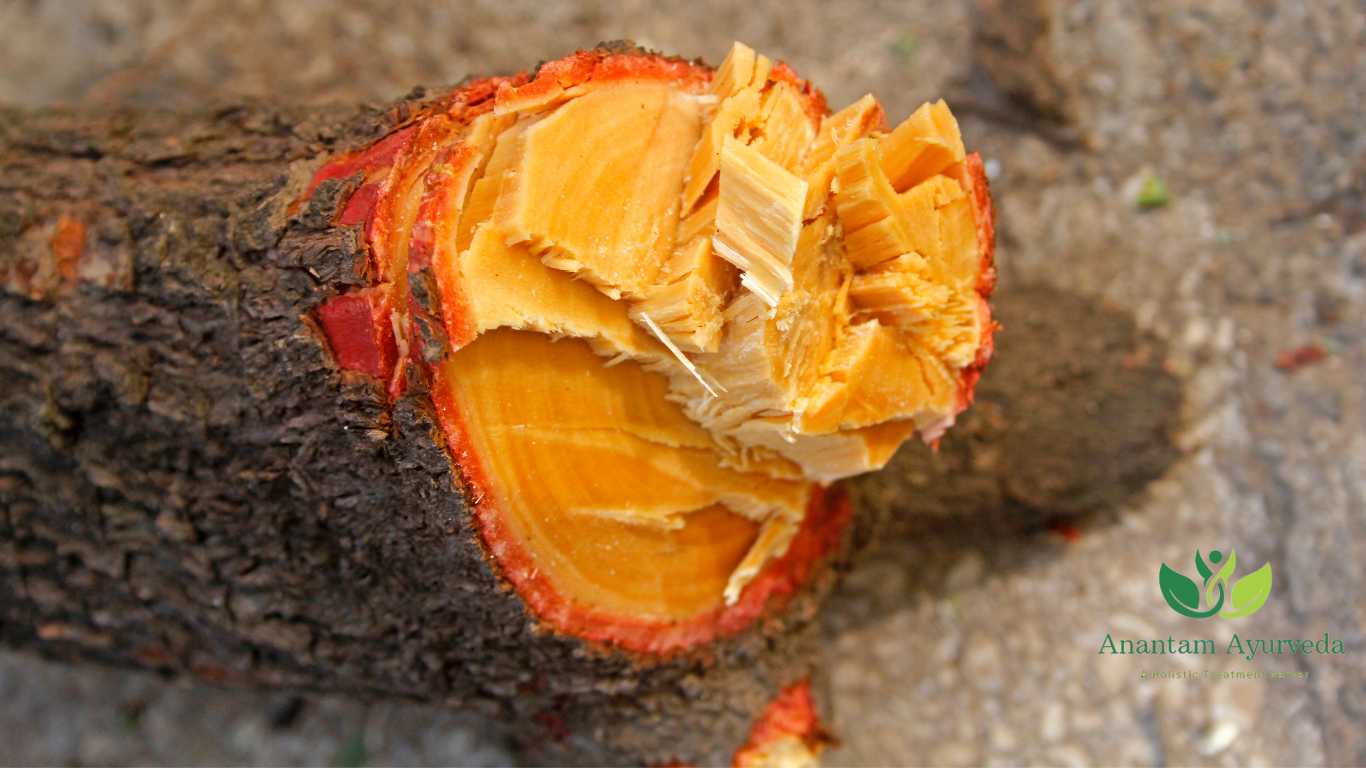
Health Benefits
Pterocarpus santalinus, has been a staple in Ayurvedic medicine for centuries, celebrated for its numerous health benefits. Here are some of the key health benefits:
- Skin Health: It promotes healthy skin. It has natural antibacterial and anti-inflammatory properties, making it effective in treating acne, pimples, and various skin infections. Red Sandalwood paste or oil can be applied topically to soothe and rejuvenate the skin.
- Cooling Effect: Its cooling nature (shita virya) makes Red Sandalwood particularly beneficial during hot summer months. It helps in reducing body heat and provides relief from conditions like heatstroke and prickly heat.
- Anti-Inflammatory: Red Sandalwood’s anti-inflammatory properties make it useful for reducing inflammation and swelling. It can be applied externally to alleviate conditions such as sunburn, insect bites, and rashes.
- Respiratory Support: In Ayurveda, It is helpful to address respiratory issues. Its anti-inflammatory and antimicrobial qualities can help ease symptoms of bronchitis, asthma, and coughs by soothing irritated airways.
- Digestive Aid: Red Sandalwood’s cooling potency can help in pacifying excess heat in the digestive system. It aids in improving digestion, reducing acidity, and soothing the gastrointestinal tract.
- Joint Health: Its anti-inflammatory properties extend to providing relief from joint pain and arthritis. Red Sandalwood paste, when applied externally, can help alleviate discomfort and swelling associated with these conditions.
- Balancing Doshas: It balances the doshas, particularly Pitta dosha. It helps in maintaining harmony within the body by reducing excess heat and inflammation.
- Ayurvedic Formulations: It is a key ingredient in many Ayurvedic formulations, including herbal face packs, oils, and medicines. These preparations leverage its therapeutic properties to target specific health concerns.
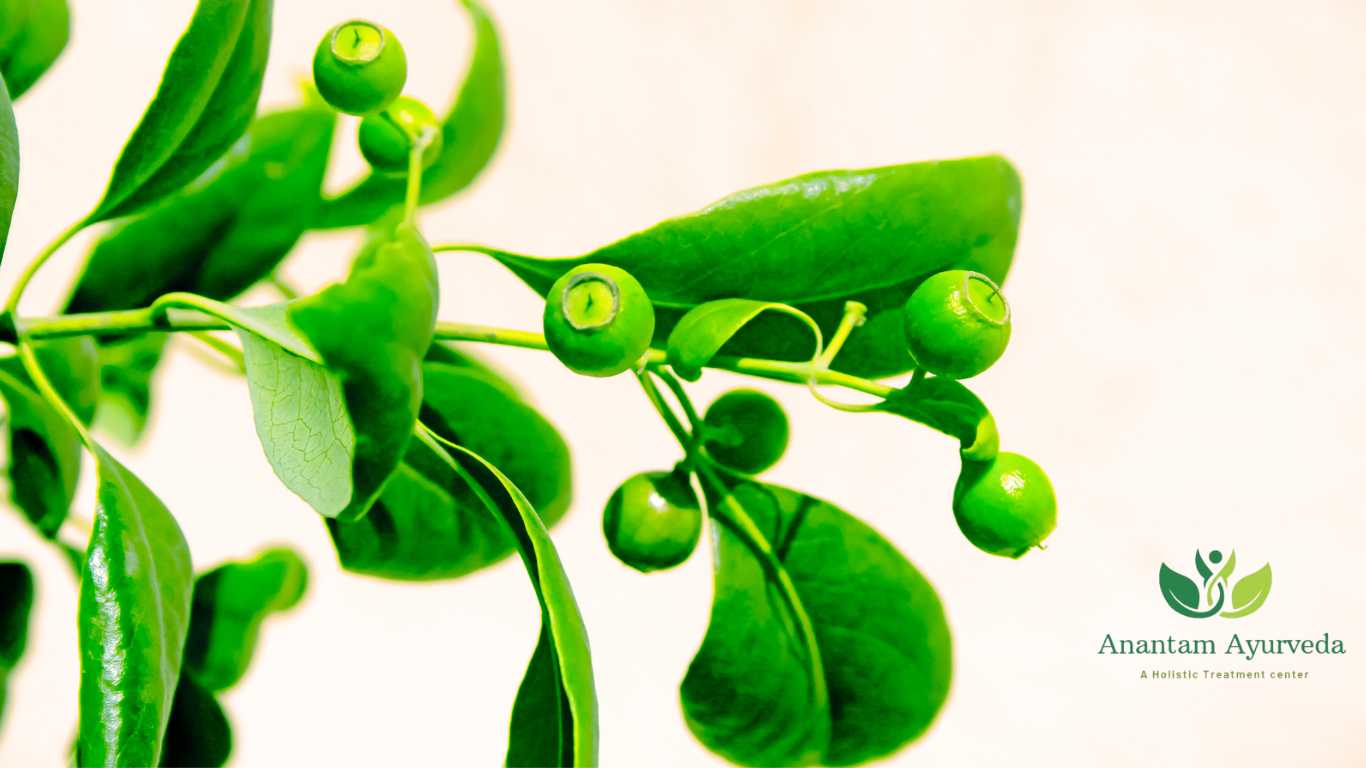
How to Use
Here’s a guide on how to use it in accordance with Ayurvedic principles:
1. Red Sandalwood Paste:
- Prepare a paste by mixing Red Sandalwood powder with a suitable liquid, such as water, rose water, or milk.
- Apply this paste topically to the skin to soothe skin conditions like acne, pimples, sunburn, and rashes.
- Leave the paste on for about 15-20 minutes and then rinse it off with lukewarm water.
2. Aromatherapy:
- Red Sandalwood essential oil can be useful in aromatherapy to promote relaxation and reduce stress and anxiety.
- Add a few drops of Red Sandalwood essential oil to a diffuser or to a bowl of hot water, and inhale the soothing aroma.
- Alternatively, add a few drops of the essential oil to your bathwater for a calming bath experience.
3. Respiratory Support:
- Boil water and add a few drops of Red Sandalwood essential oil to the steaming water.
- Inhale the steam by covering your head with a towel, keeping your face at a safe distance to avoid burns. This can help ease breathing difficulties.
4. Internal Use (Under Expert Guidance):
- In some Ayurvedic formulations, Red Sandalwood powder is useful internally. However, one should only do this under the guidance of an Ayurvedic practitioner, as improper internal use can result in adverse effects.
5. Face Masks and Beauty Treatments:
- Red Sandalwood powder in combination with other natural ingredients like turmeric, yogurt, honey, or rose water to create rejuvenating face masks.
- These masks can be applied to the face and neck to improve skin complexion, reduce blemishes, and provide a natural glow.
6. Ayurvedic Products:
- Many Ayurvedic skincare and wellness products contain Red Sandalwood as an ingredient. These products are formulated for specific purposes and can be used as recommended on their labels.
7. Incense and Perfumes:
- It is often used in incense sticks and perfumes for its pleasant and calming fragrance.
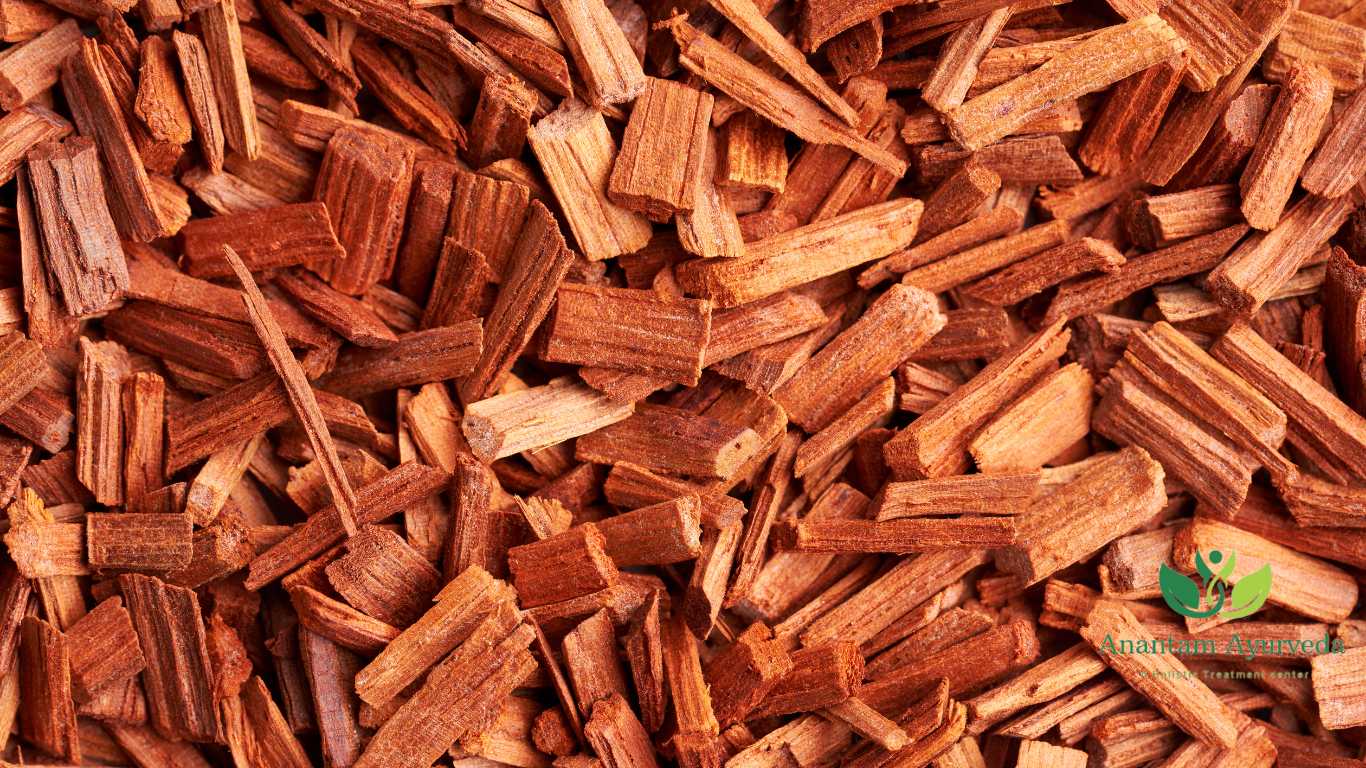
Safety and Precautions
While it offers a myriad of benefits, it’s essential to use it responsibly:
- Always perform a patch test before using it on your skin to check for any allergic reactions.
- Ensure you purchase products from reputable sources to guarantee purity and quality.
- If you’re pregnant, nursing, or have specific medical conditions, consult with a healthcare professional before using it.
In conclusion Pterocarpus santalinus, stands as a testament to the wisdom of ancient traditions. Its remarkable qualities, as recognized in Ayurveda, continue to benefit modern wellness seekers. Whether you seek skin rejuvenation, respiratory support, it offers a natural and holistic approach to better health. Embrace this timeless gift from nature and experience the transformational power of Red Sandalwood firsthand.

Frequently Asked Questions (FAQs) about Rakta chandan
Q1: How to make Red Sandalwood paste?
To make paste, follow these steps:
-
Mix 1 tsp of Red Sandalwood powder with 2 tsp of gram flour.
-
Add a few drops of fresh lemon juice and rose water to create a paste.
-
Apply this paste to the affected skin area and allow it to dry.
-
Rinse the face with cold, clean water to remove the paste.
Q2: Can we use Red Sandalwood during pregnancy?
Yes, It is considered safe when consumed in food amounts during pregnancy. However, it is always advisable to consult a physician before using Red Sandalwood or any herbal remedy during pregnancy.
Q3: Is Red Sandalwood beneficial in dysentery?
Yes, Red Sandalwood fruit decoction is helpful in dysentery due to its astringent properties. It helps reduce the discharge of mucus from the intestines, providing relief from dysentery.
In Ayurveda, Pravahika (dysentery) is caused by an imbalance in Kapha and Vata doshas. Red Sandalwood’s Grahi (absorbent) and Sita (cold) properties help reduce inflammation and control bleeding.
Q4: Is Red Sandalwood beneficial in maintaining cholesterol levels?
Yes, it helps manage cholesterol levels due to its antioxidant and anti-inflammatory properties. It lowers total cholesterol, LDL (bad) cholesterol, and triglycerides, while increasing HDL (good) cholesterol.
Q5: Can Red Sandalwood be used to manage liver problems?
Yes, it is useful for liver protection due to its hepatoprotective properties. The antioxidants, such as flavonoids, help fight free radicals and prevent liver cell damage, thus protecting the liver.
Q6: Does Red Sandalwood help in Diabetes?
Yes, it may help manage diabetes by preventing damage to pancreatic cells and improving insulin secretion. Studies suggest the heartwood and bark of Red Sandalwood can help manage blood sugar levels.
Diabetes (Madhumeha) is associated with an imbalance in Vata and Kapha doshas, leading to disturbed insulin levels. Red Sandalwood’s Kapha-balancing and Tikta (bitter) properties help manage diabetes by regulating blood sugar levels.
Q7: Can Red Sandalwood be used for wound healing?
Yes, Red Sandalwood oil promotes wound healing due to its antioxidant, anti-inflammatory, and antimicrobial properties. It helps with wound contraction, collagen formation, and skin cell regeneration. Additionally, its antibacterial properties reduce the risk of infection at the wound site.
Red Sandalwood’s Ropan (healing) property aids in wound healing. It also reduces swelling, burning, or irritation due to its Shothhar (anti-inflammatory) and Sita (cold) properties.
Tips for using Red Sandalwood on wounds:
-
Rub a small piece of Red Sandalwood in water to form a thick paste.
-
Apply it to the affected area for relief.
Q8: Does Red Sandalwood help with headaches?
Yes, it can alleviate headaches due to its cooling and relaxing properties. Applying a paste of Red Sandalwood on the forehead can provide relief.
Headaches are typically caused by an imbalance in Pitta dosha. Red Sandalwood helps balance Pitta and provides a calming, cooling effect.
Tips for using Red Sandalwood for headaches:
-
Mix 3-6g of Red Sandalwood powder with rose water or plain water to form a paste.
-
Apply it to the forehead once a day to relieve headaches.
Q9: Is Red Sandalwood beneficial for boils?
Yes, it has antibacterial and anti-inflammatory properties, making it effective for treating boils. It prevents bacterial growth and reduces inflammation when applied as a paste on boils.
Red Sandalwood helps in managing boils by promoting healing and reducing swelling and irritation due to its Ropan (healing), Shothhar (anti-inflammatory), and Sita (cooling) properties.
Tips for using Red Sandalwood on boils:
-
Rub a small piece of Red Sandalwood in water to form a thick paste.
-
Apply it to the affected area for relief.
Q10: Is Rakta chandan good for the skin?
Yes, Rakta chandan is known to refresh and purify the skin, making it spotless and glowing.
Q11: How to use Rakta chandan powder on the skin?
To use Red Sandalwood powder for skin care:
-
Take 1 tablespoon of Rakta chandan powder.
-
Add 4-5 drops of rose water and mix well.
-
Apply the paste to the skin for a cooling effect and to reduce inflammation due to its Sita (cooling) nature.
Q12: Can Rakta chandan oil be used on the skin?
Yes, Rakta chandan oil is commonly used in cosmetics for moisturizing and rejuvenating the skin. It helps remove dryness, making the skin soft, supple, and glowing.
How to use Red Sandalwood oil on the skin:
-
Take 2-3 drops of Red Sandalwood oil.
-
Mix with a carrier oil like almond oil.
-
Massage it onto the skin in circular motions for 2-5 minutes, then leave it on.
Q13: What are the things to keep in mind while using essential oils?
Essential oils are highly concentrated and should be used with caution:
-
Avoid overuse of essential oils.
-
Keep essential oils away from your eyes.
-
Do not ingest essential oils.
-
Dilute essential oils before applying them to the skin.
-
Perform a patch test before full application.
-
Consult a doctor if pregnant, breastfeeding, or on medication.
Q14: How to use Red Sandalwood at home?
Here are a few ways to use it at home:
-
Add a few drops to your lotion or moisturizer.
-
Include it in your face mask with rosewater.
-
Use it to scent your home by heating it in water.
-
Add it to your bathwater for a soothing experience.
Q15: Can we use Red Sandalwood oil directly on the skin?
Essential oils, including Red Sandalwood oil, should not be applied directly to the skin due to their high concentration. Dilute the oil with a carrier oil and perform a patch test before using it.
Patch test:
-
Mix 1 drop of essential oil with 1 tablespoon of carrier oil.
-
Apply the mixture to a small area on your forearm.
-
If there’s no allergic reaction within 24-48 hours, it is safe to use.
You can also read about Dengue.
You can follow us on twitter, facebook, instagram & Google News

1 Comment